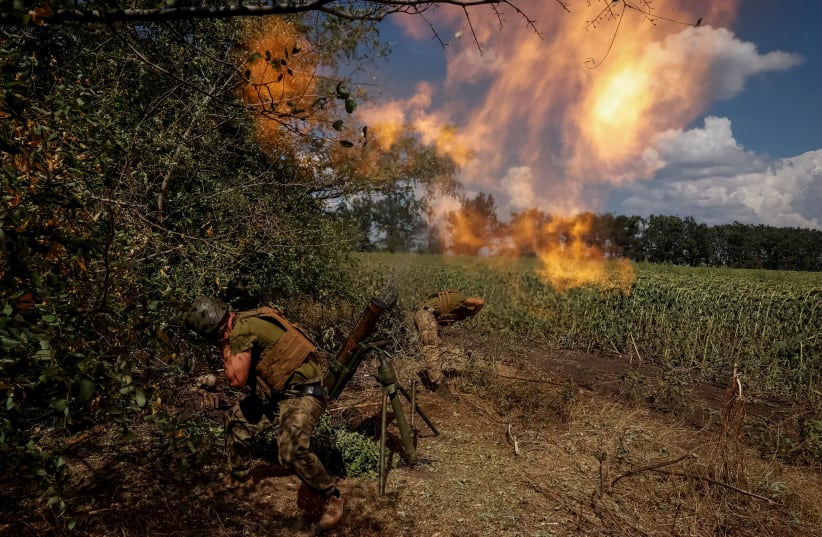[Donestk, Ukraine] The famous Ukrainian 93rd Mechanized Brigade has been at the forefront of the battle against the Russians in the Kharkiv and Donetsk regions and is now using new and evolving aerial warfare and tactics to put the Russian forces on the defensive.
“Drones in modern warfare are the eyes and I really hope that we will have much more of these eyes in the sky,” Alex, a drone operator in the 93rd Brigade, explains near the Donetsk front lines.
He adds, “We are engaged in reconnaissance and work in the air against the enemy [the Russians] all the time [here].”
His commander, the 30-something, well-built Kostyantyn from eastern Ukraine is even more explicit about the importance of drones in all aspects of this war.
“Drones in modern warfare are the eyes and I really hope that we will have much more of these eyes in the sky.”
Alex, a drone operator in the 93rd Brigade
“Yes, we use drones, all types of drones, to combat them [the Russians] in the skies. … We have a lot of specialist types, some for surveillance, some for defense, and some for the attack.”
This small but dedicated drone unit was fighting in southeastern Kharkiv but has now been transferred to the front lines in Donetsk.
“We were transferred here because the 93rd Brigade has a lot of experience and many specialists who can defend these areas, repel the enemy, and push them back. Now we need to align to the front line [here] and push the Russians back further in Donetsk,” Kostyantyn defiantly tells us.
Their base was at Barvinkove, a city in the Izyum region of Kharkiv Oblast, 70 miles north of Donetsk.
Barvinkove and other towns south of the regional capital Kharkiv were recently used as a staging post for a massive counteroffensive against the Russia forces in the area.
The conflict since September
Since late September, Ukrainian forces have made massive gains, pushing south in Kharkiv Oblast and seizing some 8,000 square kilometers (3,089 square miles) of territory from the Russians, according to Ukrainian officials.
The capture of this territory and in particular the large town of Izyum, 25 miles north of Barvinkove, effectively cuts of the Russian forces from the whole of Kharkiv Oblast and threatens their position to the south in the Donestk region.
The loss of Izyum is of key military importance as it was a logisitical hub for the Russians from which they were supplying troops and equipment to the east in the Donbas region to attack places like Kramatorsk and Sloviansk, which they were aiming to capture at the start of their so-called special operation in Ukraine.
In response to the recent Ukrainian successes of the offensive in southern Kharkiv, Kyiv’s official in charge of the eastern Donetsk region, partially controlled by pro-Moscow separatists since 2014, said Russian forces had attacked the entire front-line region.
Pavlo Kyrylenko, Ukraine’s Donetsk governor, said at least one civilian had been killed in the attacks and again urged all others to leave, describing the order as a “matter of life and death.”
This drone unit has been actively fighting in the area to the south of the strategically important city of Kramatorsk and has provided aerial support to the 93rd Brigade’s ground troops to enable them to defend against Russian attacks like these.
The brigade has also built an extensive network of forwarding positions and tunnels in Donetsk, to defend from and also launch their drones from.
“Trenches are very important. If the trenches are deep enough, then more people will be alive. It takes thousands of missiles to drive people out of the trenches,” Kostyantyn says while showing a newly built trench system on the outskirts of their base.
He adds, “There are also places where we can hide our drones and operate them from.”
Following the retreat of Russia from Izyum and Kharkiv, the Ukrainian forces now have much smaller supply lines and the capacity to focus more of their direct attacks on the Donetsk region.
However, with an estimated 80% of the residential building in Izyum destroyed and many civilians being killed in the battle, the liberation of Donestk could also become a lot bloodier and more costly.
“The Russian occupiers plundered and plundered all the pharmacies [and] only about 10,000 people now remain in Izyum – about one-fifth of the city’s pre-war population,” Maksym Strelnyk, a deputy on the Izyum city council, told the Kyiv Post shortly after surveying the damage following the Ukraine forces’ liberation of the city.
Following this defeat and the complete withdrawal from Kharkiv Oblast of the remaining Russian forces, Moscow launched a barrage of missile attacks at infrastructure targets in the area, including the power station on Kharkiv’s western outskirts, which killed at least one person, and left the city without electricity for days.
President Volodymyr Zelensky denounced the “deliberate and cynical missile strikes” against civilian targets as acts of terrorism.
It is feared that this targeting of infrastructure and killing of civilians could further intensify as the Ukrainian attempt to liberate more territory in Donetsk. Something that is also of deep concern to residents in Kostyantynivka near the front lines.
“About a month ago, a shell hit the pumping station and we have been without water for about a month; [thankfully,] there is electricity, but there has been no gas since May,” Beleniuk Natalia explains from the city center, not far from the 93rd Brigade’s forward operating base.
She adds, “The situation in the Kostyantynivka is very disturbing [now]. We have missile attacks almost every day. Just today, at 5 am, a missile hit a school.”
And with the inability of the Russians or Ukrainians to maintain any meaningful air dominance or security over Donetsk, and the breakdown of direct peace talks in Turkey in April, civilians and infrastructure are likely to continue being hit by random strikes from either side until the war is over.
